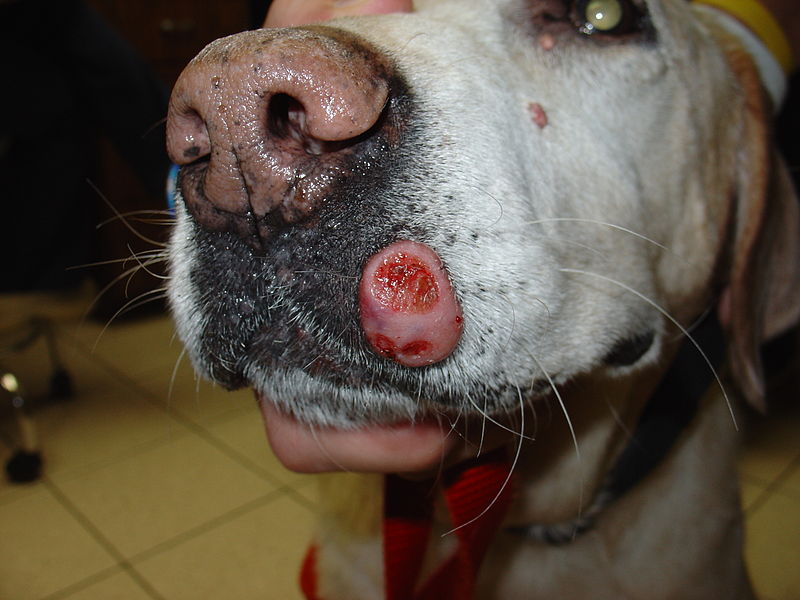 Mast cell tumor on the lip of a 13-year old Labrador Retriever. Photo by Joel Mills via Wikipedia Commons
Has your pet ever been affected by one of the great imitators in veterinary medicine? The Mast cell tumor (MCT) is just that in being a type of malignant cancer that can take on many appearances and look like other mass-like lesions that generate less concern like lipoma (benign tumor of fat), cysts, abscesses (bacterial infection), and more.
The great imitator quality of MCT make it imperative that we veterinarians recommend to our clients and perform on our patients diagnostic testing like fine needle aspirate (FNA) and cytology (microscopic evaluation of FNA-collected material).
Being aware of the clinical signs of cancer is essential in catching MCT early in the disease course. General practice veterinarian can execute the initial steps in diagnosing MCT and even perform some of the staging that must occur once the MCT diagnosis is made, like radiographs (x-rays), ultrasound (abdomen +/- other body systems), blood and urine testing, etc. When MCT is so severe or if a general practice veterinarian does not have the experience or abilities to handle the case then a referral should be made to a veterinary oncologist who can drive the proverbial ship in recommending diagnostic testing and treatment (including clinical trials).
Interested in learning more about Mast cell tumors? Check out this article Mast Cell Tumors in Canines & Felines – What You Need to Know
Mast cell tumor on the lip of a 13-year old Labrador Retriever. Photo by Joel Mills via Wikipedia Commons
Has your pet ever been affected by one of the great imitators in veterinary medicine? The Mast cell tumor (MCT) is just that in being a type of malignant cancer that can take on many appearances and look like other mass-like lesions that generate less concern like lipoma (benign tumor of fat), cysts, abscesses (bacterial infection), and more.
The great imitator quality of MCT make it imperative that we veterinarians recommend to our clients and perform on our patients diagnostic testing like fine needle aspirate (FNA) and cytology (microscopic evaluation of FNA-collected material).
Being aware of the clinical signs of cancer is essential in catching MCT early in the disease course. General practice veterinarian can execute the initial steps in diagnosing MCT and even perform some of the staging that must occur once the MCT diagnosis is made, like radiographs (x-rays), ultrasound (abdomen +/- other body systems), blood and urine testing, etc. When MCT is so severe or if a general practice veterinarian does not have the experience or abilities to handle the case then a referral should be made to a veterinary oncologist who can drive the proverbial ship in recommending diagnostic testing and treatment (including clinical trials).
Interested in learning more about Mast cell tumors? Check out this article Mast Cell Tumors in Canines & Felines – What You Need to Know
 Dr. Patrick Mahaney
Dr. Patrick Mahaney
Please leave your constructive perspective in the below Comments section and communicate with me and follow my adventures in veterinary medicine and life via Instagram (@PatrickMahaney), Twitter (@PatrickMahaney), and Facebook (Patrick Mahaney: Veterinarian Acupuncture Pain Management for Your Pets).
Copyright of this article (2017) is owned by Dr. Patrick Mahaney, Veterinarian, Certified Veterinary Acupuncturist, and Certified Veterinary Journalist. Republishing any portion of this article must first be authorized by Dr. Patrick Mahaney. Requests for republishing must be approved by Dr. Patrick Mahaney and received in written format.
